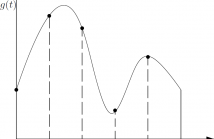
- Read more about Symmetric Polynomial & CRT Based Algorithms for Multiple Frequency Determination from Undersampled Waveforms
- Log in to post comments
Frequency estimation, especially with sampling rates below the Nyquist rate, has abundant applications in engineering. Recently, Chinese remainder theorem(CRT)-based frequency reconstruction from undersampled complex-value waveforms becomes one of the frontier focuses in the fields of signal processing, electromagnetism and optics etc. In this paper, we present several CRT-based algorithms for determining multiple frequencies via symmetric polynomials. The computational complexity of these algorithms is in the polynomial class (P).
- Categories:
 4 Views
4 Views
- Read more about Sparse Linear Regression via Generalized Orthogonal Least-Squares
- Log in to post comments
- Categories:
 3 Views
3 Views
- Read more about Robust Estimation of Self-Exciting Point Process Models with Application to Neuronal Modeling
- Log in to post comments
We consider the problem of estimating discrete self- exciting point process models from limited binary observations, where the history of the process serves as the covariate. We analyze the performance of two classes of estimators: l1-regularized maximum likelihood and greedy estimation for a discrete version of the Hawkes process and characterize the sampling tradeoffs required for stable recovery in the non-asymptotic regime. Our results extend those of compressed sensing for linear and generalized linear models with i.i.d.
- Categories:
 19 Views
19 Views
- Read more about Estimation of Spatial Fields from Samples obtained at Unknown Random Locations
- Log in to post comments
Sampling and estimation of spatial fields using sensors which are location unaware is an exciting
topic. Here we study this topic under the assumption that the sensors are deployed according
to a known probability distribution, under different scenarios.
The initial part of this work studies detection of bandlimited fields from location-unaware
sensors that are restricted to a discrete grid. Oversampling is used to overcome the lack of
location information. The samples obtained from location-unaware sensors are clustered together
- Categories:
 15 Views
15 Views- Read more about Low-rank Matrix Recovery via Entropy Function
- Log in to post comments
The low-rank matrix recovery problem consists of reconstructing an unknown low-rank matrix from a few linear measurements, possibly corrupted by noise. One of the most popular method in low-rank matrix recovery is based on nuclear-norm minimization, which seeks to simultaneously estimate the most significant singular values of the target low-rank matrix by adding a penalizing term on its nuclear norm. In this paper, we introduce a new method that re- quires substantially fewer measurements needed for exact matrix recovery compared to nuclear norm minimization.
- Categories:
 32 Views
32 Views- Read more about Low-rank Matrix Recovery via Entropy Function
- Log in to post comments
- Categories:
 18 Views
18 Views- Read more about SIGNAL RECONSTRUCTION IN THE PRESENCE OF SIDE INFORMATION: THE IMPACT OF PROJECTION KERNEL DESIGN
- Log in to post comments
- Categories:
 6 Views
6 Views- Read more about Reconstructing Non-point Sources of Diffusion Fields From Sensor Measurements
- Log in to post comments
- Categories:
 8 Views
8 Views